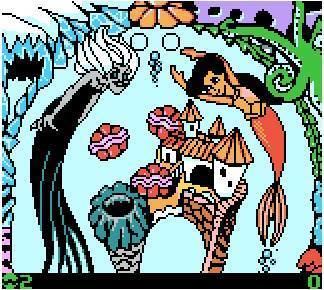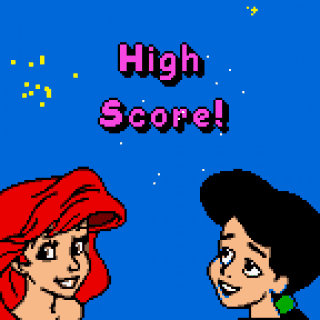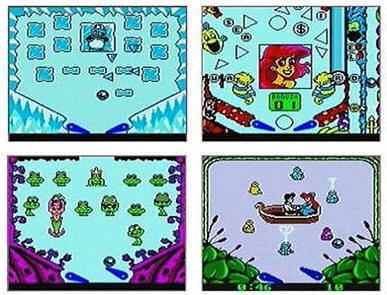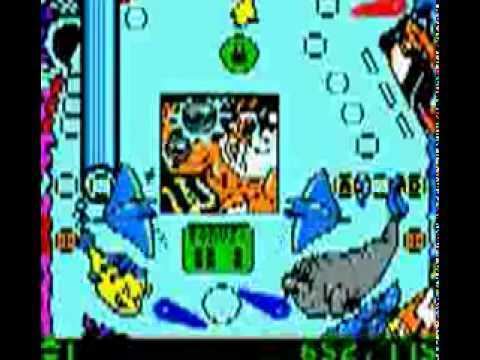9 /10 1 Votes
5/5 eBay Initial release date 24 September 2000 Platform Game Boy | 5/5 Emuparadise 7/10 IGN Genre Pinball | |||||||||||||||||||||||||||||||||
 | ||||||||||||||||||||||||||||||||||
Similar Left Field Productions games, Pinball games, Other games | ||||||||||||||||||||||||||||||||||
The little mermaid ii pinball frenzy gbc my ball has warped
The Little Mermaid II: Pinball Frenzy is a video game developed by Disney Interactive Studios and Left Field Productions and published by Nintendo of America, Inc. for the Game Boy Color. It was first released in September 2000 in North America and was later released on March 16, 2001, in PAL regions. The game features two pinball tables based on the animated films The Little Mermaid and The Little Mermaid II: Return to the Sea, with each being represented by Ariel and her daughter Melody respectively. It also includes sixteen unlockable minigames, and supports up to four players through alternating tables. Critical response to the game was primarily positive, with reviewers praising its visuals and appeal to girls. Some critics questioned the decision to create a title based on The Little Mermaid. The game was compared several times to Pokémon Pinball.
Contents
- The little mermaid ii pinball frenzy gbc my ball has warped
- Little mermaid 2 pinball frenzy for gameboy color
- Gameplay
- Development and release
- Reception
- References

Little mermaid 2 pinball frenzy for gameboy color
Gameplay

The Little Mermaid II: Pinball Frenzy is a 2D fantasy, pinball, video game featuring two pinball tables. The tables are based on the Walt Disney Pictures' 28th animated feature film The Little Mermaid (1989) and its direct-to-video sequel The Little Mermaid II: Return to the Sea (2000), with each being represented by Ariel and her daughter Melody respectively. The game is built on a different engine than those used for the previously released pinball titles: Pokémon Pinball and Kirby's Pinball Land. It is played in a top-down perspective, with vertical scrolling. Both tables include "flippers, multipliers, bonus targets, and multiballs", which are standard gameplay elements for pinball video games. Objectives for the tables include: performing timed skill shots, earning bonus points, and contending with three balls at once. The game incorporates new features absent from Pokémon Pinball, such as ball traps.

The player can adjust the game's difficulty by selecting three of five balls per game; they can also set the ball speed to either slow or fast: "Turtle" or "Rabbit". According to CNET, the game has a medium difficulty, and has a learning curve of roughly half an hour. The game has a rumble feature, which vibrates the Game Boy Color when turned on with an extra battery. It also supports up to four players through alternating tables. High scores are recorded allowing players to compare them with friends.

The player can unlock sixteen minigames by earning points and completing activities. The minigames are divided equally between the tables for Ariel and Melody. They are based on scenes from the films: in one minigame, the player whacks frogs and fish during the "Kiss the Girl" sequence, while the player helps Melody escape from a frozen block of ice in another. If the player successfully finishes a minigame, it becomes accessible for replay from the main menu. The tables also include other references to the films, such as images of Ariel's Grotto and Ursula's Cave and guest appearances by Flounder, Sebastian, and Dash among other characters. The menus, tables, and minigames each feature a unique background score.
Development and release
The Little Mermaid II: Pinball Frenzy was developed by Disney Interactive Studios and Left Field Productions; it was published by Nintendo of America, Inc.. Disney Interactive Studios served as a "license holder for externally-developed products," which included characters from Disney and other media franchises. It focused on the creation and marketing of "children's entertainment and learning software" across multiple gaming platforms and with various business. The game was released exclusively on Game Boy Color on September 24, 2000, and was later made available on March 16, 2001, in PAL regions. The manual included a list of the mini-games and table games, and a glossary of pinball-related terms. The game supported the use of the Game Boy Printer.
According to LifeZette, pinball video games from the first half of the 2000s were released with "very little anticipation" of success with audiences. LifeZette's Josh Smith wrote that they all relied on a similar formula: "Make it classic, or add popular characters." Titles based on other franchises, such as Metroid and Pac-Man, were also published alongside those for The Little Mermaid. However, Brett Allan Weiss of AllGame wrote that pinball video games were popular and achieved a status as "a harmless game of skill and chance that can be played by thrill-seekers of all ages and persuasions." Weiss followed this up by saying that the release of The Little Mermaid II: Pinball Frenzy reflected how pinball had become a widely accepted activity on the same level as baseball and checkers.
Reception
The critical response to The Little Mermaid II: Pinball Frenzy was primarily positive, with many video game commentators complimenting its visuals and appeal to girls. It was determined to be a good fit for a female gamer by IGN's Craig Harris. However, Harris was more critical of the physics of the pinballs, describing the mechanics as "a little on the floaty side" and "not as quick as the previous pinball incarnations." Frank Provo of GameSpot felt the game would be popular with a younger audience, and complimented the vibrant colors of the tables and recreation of the films' soundtracks. The minigames and tables' designs were praised by a writer from Spong.com, who felt the game was a "polished, playable pinball title that deserves checking out." Brett Allan Weiss of AllGame thought the game's multiplayer tournaments and adjustable difficulties encouraged family members to play together.
Some commentators were critical of the decision to base a video game on The Little Mermaid II: Return to the Sea. A writer for GamesRadar considered it to be an example of "sheer exploitation", and felt it was "a game no one asked for, based on a sequel fans hated, representing a genre its intended demographic was too young to remember". Game Informer's Jay Fitzloff argued that the game was unsuitable for a male gamer, expressing concern that "owning this title will brand them a pansy for the rest of their elementary school careers." Although Fitzloff called the game a "worthwhile pastime", he argued that it was not worth the possibility of being bullied at school.
Critics have also frequently compared The Little Mermaid II: Pinball Frenzy to Pokémon Pinball. Gamekult.com's Usul wrote that The Little Mermaid II: Pinball Frenzy had a superior design and richer gameplay experience than Pokémon Pinball. Craig Harris expressed a preference for the previous Nintendo pinball releases. The game was described as a remake of Pokémon Pinball by Frank Provo, who expressed disappointment at the absence of Pikachu and other Pokémon. Brett Alan Weiss argued that the cute visuals of The Little Mermaid II: Pinball Frenzy was derivative when compared to other pinball games. He followed this up by writing that the game would appeal primarily to young girls, while experienced pinball players would prefer Pokémon Pinball.
